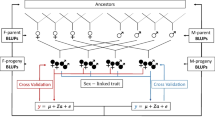Summary
Seeds of Anthoxanthum odoratum were transplanted reciprocally between a xeric and a mesic field population that were genetically differentiated in adult traits. In one experiment seeds were reciprocally buried in bags in the soil, in a second experiment seeds were reciprocally sown in small plots. For most traits, site effects were much larger than seed-source effects. Germination, emergence, mortality of buried seed and recruitment were significantly higher at the xeric site than at the mesic site, irrespective of population of origin. Seed dormancy, was significantly higher for seed originating from the mesic than from the xeric population. Seedling recruits originating from the xeric population tended to be larger at both sites. Fecundity of seedling recruits depended on the environment; fecundities of plants growing in the xeric site had more than double the fecundity of plants growing in the mesic site. Phenotypic plasticity rather than population differences determined variation in performance in the seed and seedling stages.
Similar content being viewed by others
References
Antonovics J, Ellstrand NC (1984) Experimental studies of the evolutionary significance of sexual reproduction. I. A test of the frequency-dependent selection hypothesis. Evolution 38:103–115
Antonovics J, Schmitt J (1986) Paternal and maternal effects on propagule size in Anthoxanthum odoratum. Oecologia 69:277–282
Aston JL, Bradshaw AD (1966) Evolution in closely adjacent plant populations. II. Agrostis stolonifera in maritime habitats. Heredity 21:649–664
Cresswell EG, Grime JP (1981) Induction of a light requirement during seed development and its ecological consequences. Nature 291:583–585
Falconer DS (1989) Introduction to quantitative genetics. Third edition. Longman, London
Foin TC, Hektner MM (1986) Secondary succession and the fate of native species in a California coastal prairie community. Madroño 33:189–206
Gottlieb LD (1977) Genotypic similarity of large and small individuals in a natural population of the annual plant Stephanomeria exigua ssp. coronaria (Compositae). J Ecol 65:127–134
Harper JL (1977) Population Biology of Plants. Academic Press, London
Hartgerink AP, Bazzaz FA (1984) Seedling-scale environmental heterogeneity influences individual fitness and population structure. Ecology 65:198–206
Hickey DA, McNeilly T (1975) Competition between metal tolerant and normal plant populations: a field experiment on normal soil. Evolution 29:458–464
International Seed Testing Association (1985) International rules for seed testing. Annexes 1985. Seed Sci Tech 13:356–513
Jain SK (1982) Variation and adaptive role of seed dormancy in some annual grassland species. Bot Gaz 143:101–106
Jana S, Naylor JM (1980) Dormancy studies in seed of Avena fatua. II. Heritability for seed dormancy. Can J Bot 58:91–93
Kalisz S (1985) Variable selection on the timing of germination in Collinsia verna (Scrophulariaceae). Evolution 40:479–491
Lee HS, Zangerl AR, Garbutt K, Bazzaz FA (1986) Within and between species variation in response to environmental gradients in Polygonum pennsylvanicum and Polygonum virginianum. Oecologia 68:606–610
Mazer SJ (1987) The quantitative genetics of life-history and fitness components in Raphanus raphanistrum L. (Brassicaceae): ecological and evolutionary consequences of seed-weight variation. Am Nat 130:891–914
Parrish JAD, Bazzaz FA (1985) Ontogenetic niche shifts in oldfield annuals. Ecology 66:1295–1302
Peart DR (1989) Species interactions in a successional grassland. III. The effects of canopy gaps, gopher mounds and grazing on colonization. J Ecol 77:252–266
Peart DR, Foin TC (1985) Analysis and prediction of population and community change: a grassland case study. In: White J (ed) The Population Structure of Vegetation. Handbook of Vegetation Science. Dr. W. Junk, Dordrecht, The Netherlands, pp 313–339
Platenkamp GAJ (1990) Phenotypic plasticity and genetic differentiation in the demography of the grass Anthoxanthum odoratum. J Ecol 78:772–788
Platenkamp GAJ, Foin TC (1990) Ecological and evolutionary importance of neighbors in the grass Anthoxanthum odoratum. Oecologia 83:201–208
Rice KJ (1987) Evidence for the retention of genetic variation in Erodium seed dormancy by variable rainfall. Oecologia 72:589–596
Roach DA (1987) Variation in seed and seedling size in Anthoxanthum odoratum. Am Midl Nat 117:258–264
Roach DA, Wulff RD (1987) Maternal effects in plants. Ann Rev Ecol Syst 18:209–235
SAS Institute (1985) SAS User's guide: statistics. SAS Institute, Cary, North Carolina
Schaal BA (1984) Life-history variation, natural selection, and maternal effects in plant populations. In: Dirzo R, Sarukhán J (eds) Perspectives on Plant Population Ecology. Sinauer, Sunderland, MA, pp 188–206
Scheffé H (1959) The analysis of variance. Wiley, New York
Schemske DW (1984) Population structure and local selection in Impatiens pallida (Balsaminaceae), a selfing annual. Evolution 38:817–832
Schmitt J, Antonovics J (1986) Experimental studies of the evolutionary significance of sexual reproduction. III. Maternal and paternal effects during seedling establishment. Evolution 40:817–829
Sokal RR, Rohlf FJ (1981) Biometry. Second edition. Freeman, New York
Solbrig OT (1981) Studies on the population biology of the genus Viola. II. The effect of plant size on fitness in Viola sororia. Evolution 35:1080–1093
Wu L, Jain S (1980) Self-fertility and seed set in natural populations of Anthoxanthum odoratum L. Bot Gaz 141:300–304
Wu L, Till-Bottraud I, Torres A (1987) Genetic differentiation in temperature enforced dormacy among golf course populations of Poa annua L. New Phytol 107:623–631
Author information
Authors and Affiliations
Rights and permissions
About this article
Cite this article
Platenkamp, G.A.J. Phenotypic plasticity and population differentiation in seeds and seedlings of the grass Anthoxanthum odoratum . Oecologia 88, 515–520 (1991). https://doi.org/10.1007/BF00317714
Received:
Accepted:
Issue Date:
DOI: https://doi.org/10.1007/BF00317714




